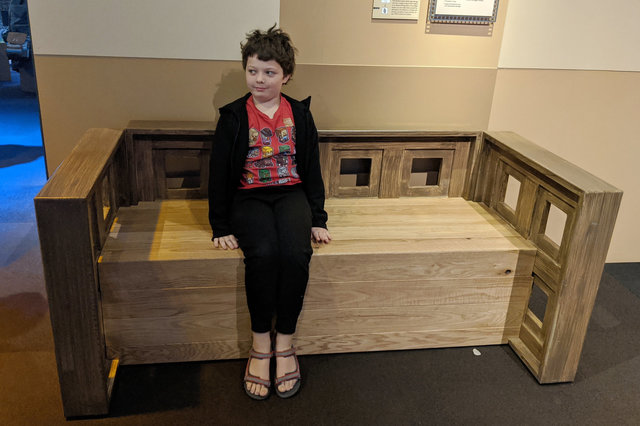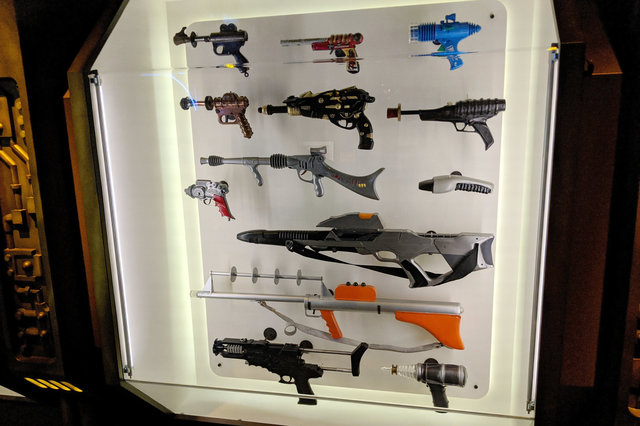MoPOP
Started: 2019-12-22 15:31:19
Submitted: 2019-12-22 23:22:36
Visibility: World-readable
30 November 2019: In which the intrepid narrator visits Seattle's most musical museum
After Thanksgiving our former au pair Echo visited us, giving us the opportunity to see a few tourist sites in Seattle. MoPOP (aka the Museum of Pop Culture, previously the Experience Music Project) was staging a Minecraft expedition, and Calvin had visited the exhibit as part of a school field trip (a field trip that I might have volunteered to chaperone for had I not been visiting London that week), but he wanted to return to spend longer in the exhibit. I had visited the museum once before, on a visit to Seattle in 2011, and I was interested in seeing it again.
We drove to Seattle Center, parked across the street, and walked around the striking building trying to find an appropriate entrance. Once inside we stopped for hot drinks at the cafe (Echo and I got coffee, and the kids drank hot chocolate), then we proceeded into the Minecraft exhibit.
The hallways leading up to the exhibit displayed human-scale models of Minecraft items: the player avatars Steve and Alex, a one-meter-cube representing a fundamental Minecraft block, various enemies, and an Ender Dragon hanging from the ceiling. Inside the exhibit was more of the same, explaining the world of Minecraft to novices (like myself) and also surrounding us with enough amusing human-scale models, including full-sized furniture, that Calvin was enthralled.
We exited the special exhibit and headed across the hall to a hand-on exhibit showing how rock music is made. At various stations throughout the gallery there were different instruments, fixed into place and hooked up to amplifiers and speakers and outfitted with a tutorial. The first kiosk was set up with the holy trinity of rock music — guitar, bass, and drums — at different stations so we could all see each other through plexiglass but we couldn't hear each other unless we wanted to all jam together. I stepped up to the guitar, adjusted it to the right height, strummed the strings, heard the chord played back to me through the powerful speakers that dominated the tiny kiosk, and immediately felt like I was Bono striding onto stage at a giant arena. I could easily make the percussive interstitial sounds of a guitar — swishing my hand lengthwise along the strings, and tapping my hand onto the string — but I lacked the practice to make real music with the guitar.
I followed the tutorial and stumbled my way through a two-note power chord, playing along to the classic rock song they had borrowed for that purpose. It was a bit like Guitar Hero, but harder, with a real guitar at my fingertips. My dreams of rock stardom shattered as I realized how hard it was to make the instrument play, at least without a lot more practice. (Besides, I already know I can't match Bono's vocal range from trying — and failing — to sing U2 at karaoke.)
(It was while playing the guitar that I was paged for my service. By the time I pulled out my laptop and logged in to check what was happening the long-running job that I had been alerted for finished, and I was left with nothing to do.)
I wandered around the rest of the room, playing on the base guitar and the drum set as they became available. I was also interested in the guitar pedal display, which showed how the sound from the guitar pickups are distorted and manipulated to form the iconic sounds that define rock music. The display played three different samples, then let us turn on the pedals and manipulate what we heard from the speakers.
After lunch we continued through the museum, looking through the "Prince from Minneapolis" exhibit, showing photography from Prince earlier in his career — including his unpronounceable symbol that he used in the early 1990s after a dispute with his record label over who owned the trademark on the name "Prince". (This was the time period when I first became aware of the artist formerly known as Prince, as he was active experimenting with music on the Internet in the early 1990s, at the same time that I was going online and reading print magazines like Internet World.) There was a large screen showing his music videos (which Calvin was immediately attracted to) that included a weird video that used (or, one might say, abused) chroma key (the same feature used for green screen effects) to replace parts of Prince's suit with the animated scrolling clouds background. I guessed this had to be from the middle 1980s, when chroma key technology was new and cutting-edge; later I identified the video as "Raspberry Beret" from 1985.
We looked through the gallery of guitars around the corner from Prince — and it was here that the museum showed its roots from Paul Allen's personal collection of historically-important guitars. These were guitars that famous rock musicians played at important parts of their careers, suspended between glass so we could see the front and the back of the instruments. They looked like insects pinned up behind glass, but in a loving way so we could see the details of the instruments, see the components and how they were similar to each other and different from each other, see the evolution of the electric guitar through the 1950s and 1960s. It was my chance to nerd out with rock music history, and to feel a connection to Paul Allen's rock music obsession.
We got stuck in the indie games showcase in the gallery opposite, where both Calvin and Julian wanted to play the games set up at computers and consoles scattered around the room. Or, more precisely, Julian wanted to watch me play Keyboard Sports, an amusing game where the entire keyboard becomes the controller to move the character around the screen — there was an outline of a keyboard superimposed over the screen, and the character would walk to whatever key was pressed. I never felt totally comfortable with the controls — I kept wanting my character to keep moving in the same direction when I mashed a particular key, but the character would just stay there. This worked ok on the levels where all I had to do was navigate a static scene, but the end-game boss required quick real-time coordination and I couldn't beat it in the time I was willing to devote to it.
After some effort we managed to dislodge the kids from the indie games showcase into the science fiction display in the basement. Here museum displayed Paul Allen's collection of artifacts from random iconic sci-fi movies — a chrome robot endoskeleton from Terminator 2, Colonial Marine armor from Aliens, Korbin Dallas' vest and Leeloo's "thermal bandages" from The Fifth Element, and more things that I'm forgetting. None of the artifacts on display had any obvious connection to each other, and I didn't see evidence of a collection development policy that might guide artifact selection, but it was fascinating to see the real film props from iconic movies. My favorite part was the giant weapons case full of ray guns, including a phaser rifle from Star Trek: Insurrection (which wasn't a very good movie, but the prop was impressive).
We dropped by the fantasy gallery, which indulged in a bit more world-building, but had fewer overall artifacts on display. I was amused by the interactive screen encouraging one to build a fantasy map, on the theory that fantasy maps are often important to understanding the epic fantasy quest — and as I was building my map and scattering mountains and rivers at random I couldn't help but remember reading a geologist complain about fantasy map-making.
As we wrapped up the fantasy exhibit the museum was about to close, so we departed, having seen most of the museum (with two children) and gotten a good dose of pop culture from the last sixty years.





